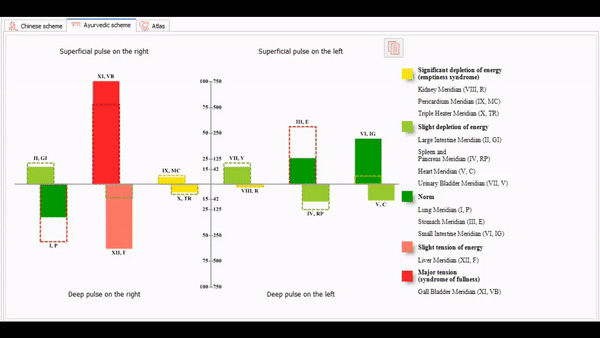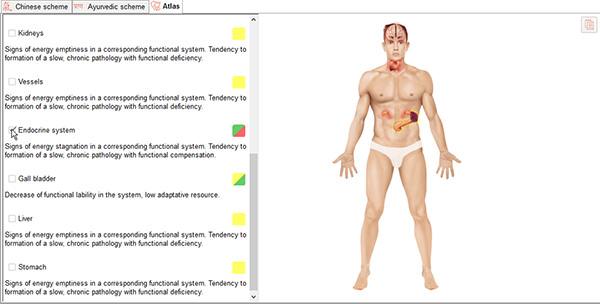Gallery
Organ pulses (Meridians)
Software expert extension "Meridians" (Organ pulses)
Organ Pulses (Meridians) is an expert extension to VedaPulse Professional designed to assess the functional state of the 12 vital organs in Traditional Chinese Medicine (TCM).
Organ Pulses module includes 3 tabs:
- Chenese scheme
- Ayurvedic scheme
- Atlas
1. Chenese scheme.

In TCM the term “Organ” has a much greater meaning than in Western medicine where it refers only to the same physiological organ itself. More closely corresponding European concept to the term is a functional system. For instance, in Chinese medicine Spleen is in charge of the whole digestive system that includes stomach, small intestine, colon, liver, gall bladder and pancreas (these physiological organs also gave the name to the “organs” in TCM). At the same time the role of Spleen as a physiological organ is much smaller - fine blood purification, removal of dead blood cells and platelets, processing of hemoglobin.
It is described in details in the article "Twelve main meridians in Traditional Chinese Medicine".
The energy of a Meridian is reflected in two graphs — functional and morphological state of an organ. These graphs have different physiological significance. Functional chenges are shown by the blue line and morphological - by the red line.
This allows any specialist to evaluate not only the functioning of the organ, but also to determine its structural changes, which is extremely important to see the real picture of a client's health.
2. Ayurvedic scheme

12 vital organs are associated to the points on the wrists intended for organs’ pulse diagnosis that is carried out with the consideration of deep and surface nature of the pulse. Different schools of traditional medicine use different schemes of location of points to assess the organs’ pulse. The module is designed basing on the system of Dr. Vasant Lad, an author of the book “Pulse diagnosis”.
Similarly to the Chinese scheme, Ayurvedic scheme represents the energy of the meridians by two graphs — relative and absolute values of energy graphs. The relative energy level is shown by a dashed line and the absolute level by colored bars. The color of the bar or dotted line reflects the energy level in the meridian.
3. Atlas

The tab shows information, presented by graphs in the first two tabs, in the form of a scheme of location of organs and systems in the human body. This scheme shows the current violations in regulation mechanisms or a particular organ. Around the organs one sees the pulsing glow, showing the state of energy in the organs. The yellow glow indicates a lack of energy (the risk zone), the red glow indicates an excess of energy (tension), and the green glow indicates normal energy level. At the same time, the zones defined in Chinese scheme and Ayurvedic scheme as 'slight depletion' and 'stress' in the Atlas tab are related to the zone of norm. The tab Atlas is good for demonstration of the functional state to the patients, and for the specialists it is recommended to work with the tabs Chinese scheme and Ayurvedic scheme.
The tab allows analyzing the absolute and relative energy values of different organs and systems simultaneously. For this, next to each item in the list of organs there are graphical elements that are associated with absolute (upper triangle) and relative values (lower triangle) of organs’ energy.
- Login to post comments
User login
Last articles










